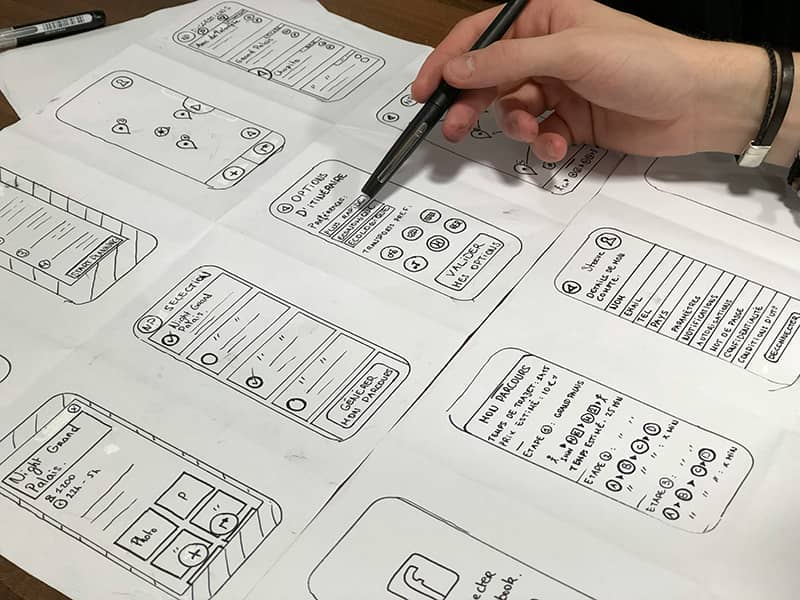Responsive Web Design - Best Practices For A Responsive Website

Table of Contents
The Best Practices For A Responsive Website
In an era where digital presence is imperative, having a responsive website is no longer optional—it’s essential. At Constructive Visual, we understand the vitality of adaptability in web design, ensuring your site delivers a seamless experience across all devices.
This article delves into the best practices for crafting responsive websites, providing actionable insights to enhance user engagement and elevate your online footprint. Join us as we explore the cornerstones of responsive web design, from fluid grids and flexible images to media queries and beyond.

Embracing the Fundamentals of Responsive Web Design
In the dynamic realm of web design, establishing a responsive website has become the cornerstone of delivering an optimal user experience. The essence of responsive web design lies in its fluidity – the ability to adapt seamlessly across various screen sizes.
As web developers, we leverage HTML and CSS to craft layouts that respond dynamically to a multitude of devices, ensuring content is easily navigable whether on a phone, tablet, or desktop. Employing media queries is critical; they are the CSS tool that allows us to apply different styling rules based on screen size.
By understanding the breadth of screen sizes and utilising media queries effectively, designers achieve responsive design that maintains visual appeal and functionality. By prioritising these responsive web design principles, Constructive Visual ensures that every user, regardless of their device, encounters a website that’s as engaging as it is accessible.

Exploring the Core Principles of Responsive Web Design
At Constructive Visual, we prioritize grasping the core principles of responsive web design to ensure an optimal experience across various screens. These principles guide the creation of websites that fluidly adapt to different screen sizes using a combination of CSS and HTML. Central to responsive website design is the concept of the viewport, which determines how content is scaled and displayed on different devices.
By employing responsive design techniques, web design professionals at Constructive Visual can test and tweak layouts to achieve seamless functionality and aesthetic appeal. Moreover, the underlying structure of a responsive website hinges on a fluid grid system, flexible images, and media queries, which are instrumental tools in CSS for building a responsive web presence.
Our commitment to these responsive web design strategies ensures that visitors have a consistent and engaging experience, regardless of the device used.

Designing for Users: Creating a User-Friendly Responsive Website
In the realm of responsive web design, user experience transcends mere aesthetics to encompass the ease of interaction between users and the website. Constructive Visual recognises that a truly responsive website must intuitively adapt not just to varied device viewports but also to the distinctive preferences of users.
By ensuring that content fluidly resizes and reorganises itself, our web design approach guarantees legibility and accessibility across all platforms. The layout of a responsive website adheres to the principles of streamline navigation, enabling users to locate information swiftly and efficiently.
We empathise with the user’s journey, meticulously crafting every aspect of the design to facilitate a seamless and engaging experience. Whether it’s through optimizing touchpoints or simplifying pathways, our responsive design fulfills the promise of a user-friendly website, where every navigation, layout, and content element converges to meet the nuanced demands of our clients’ diverse user base.

Why Users Prefer Responsive Web Design When Browsing
At Constructive Visual, we understand that users prefer responsive web design because it delivers an unparalleled browsing experience across a plethora of devices. Our approach ensures that design flexibility caters to every screen size, from mobile to tablet, fostering an environment where user satisfaction is paramount.
With responsive web design, the experience remains consistent and intuitive regardless of the device in hand. Users don’t have to sacrifice functionality or aesthetics; everything is tailored to their needs—a testament to effective design ethos. Engaging with a responsive site, users benefit from seamless navigation and faster load times, which are crucial in retaining their attention and keeping bounce rates low.
At the crux of our methodology is the preference of the user; providing them with the responsive web design they desire is not just about adapting to trends, it’s about committing to their ever-evolving browsing habits.

Responsive Web Design: Adjusting to Various Screen Resolutions
Understanding the nuances of responsive web design is crucial in today’s digitally diverse environment. With a variety of devices, each boasting different screen resolutions and sizes, a responsive website must seamlessly adapt to ensure an optimal user experience.
Utilising CSS media queries is a cornerstone in achieving true responsive design. These media queries enable web pages to apply different styling rules based on the current screen size or resolution, ensuring content is perfectly rendered regardless of the screen.
A responsive web approach isn’t just about fluid grids and flexible images—it’s about considering the myriad of screen resolutions your audience might encounter. Through responsive design techniques, Constructive Visual creates websites that maintain design integrity and functionality at every possible screen resolution, providing users with a consistently superb experience, no matter the device.

Media Queries in Action: An Example of Responsive Design for All Devices
Essential to the fabric of responsive web design, media queries have emerged as the backbone, empowering web designers to create visually consistent experiences across all devices.
A perfect implementation of media queries in CSS showcases their power when in action. By integrating these queries, styles are dynamically adjusted to accommodate the unique characteristics of every device, from the largest of desktop monitors to the most compact of smartphones.
Our responsive website example demonstrates how responsive design transmutes a static layout into a fluid interface that responds seamlessly to various screen resolutions. It’s this flexibility that users have come to prefer, striving for an unbroken digital journey, regardless of the device in hand.
At Constructive Visual, we champion the use of media queries, validating their importance in forging a truly responsive web design that caters to every need and ensures no user is left behind in the digital age.

The Role of Images in Responsive Web Design
In the realm of responsive web design, images play a pivotal role in enhancing user experience across various devices. The utilisation of images must adhere to the principles of responsive design, ensuring that they scale and adjust to fit the myriad of screen sizes encountered on the web.
CSS and HTML are at the core of adjusting images seamlessly, with CSS particularly used to ensure that images are not only responsive but also retain their quality without slowing down the page load time. A robust responsive image strategy is pivotal to web design, reflecting the design’s adaptability and consideration for users who expect an exceptional browsing experience regardless of the device they are using.
At Constructive Visual, we understand that a responsive image is a cornerstone in responsive web design, solidifying the role of such visual elements in producing a user-centric responsive experience.
Optimising Images for a Seamless Responsive Experience
In the series of techniques that constitute responsive web design, optimising images is crucial for crafting a seamless responsive experience. As the visual elements that often carry significant weight in engaging users, images must fluidly adapt to various screen resolutions without compromising quality or loading times.
The cornerstone of responsive images lies in CSS, where properties like max-width can ensure that an image is never larger than its containing element, thus maintaining its intrinsic part within the responsive layout.
By adopting responsive image solutions such as the srcset attribute, Constructive Visual ensures that browsers download the most appropriately sized image, economizing on bandwidth and improving performance. This meticulous attention to optimising each image not only enhances the responsiveness of web design but also echoes the preferences of users who expect a swift and responsive navigation experience across all devices.

Responsive Web Design and Browser Compatibility
At the heart of responsive web design lies the imperative to ensure that websites offer an optimal viewing experience across a myriad of devices, which is closely tied to browser compatibility. Constructive Visual acknowledges that a truly responsive website must perform flawlessly regardless of the browser being used, whether it be Chrome, Firefox, Safari, Edge, or any other website browser.
By focusing on browser compatibility, we emphasize the importance of inclusive access in web design, confirming that our responsive web solutions are rigorously tested across browsers to guarantee flawless functionality. Thus, crafting a responsive web landscape that users can trust for robustness and continuity, regardless of their preferred browser.
This commitment to universal browser assurance is a cornerstone of excellent web design and paramount for maintaining the integrity of a responsive website that serves its purpose effectively.
Ensuring Your Website Looks Great Across Every Browser
Responsive web design is integral to ensuring that your website looks great and functions seamlessly, irrespective of the browser it’s viewed on. By embracing responsive strategies, we address the myriad of browsers, each with its nuances, to offer users a consistent and pleasurable web experience.
A well-designed site not only reflects positively on your brand but also adheres to the best practices of browser compatibility—meaning whether it’s Chrome, Firefox, Safari, or Internet Explorer, your website maintains its aesthetic and functionality. Ensuring that your site appears impeccable across every browser is more than a technical feat; it’s a commitment to user accessibility and satisfaction. Further, as web browsers evolve, staying on top of the latest updates in design techniques becomes indispensable.
At Constructive Visual, we’re steadfast in applying these responsive web design principles to meet and exceed users’ expectations, no matter their choice of browsers.

Building a Responsive Website: Best Practices in Web Design
Building a responsive website encompasses a variety of strategies and, indeed, best practices that are paramount in responsive web design. At Constructive Visual, we understand that a good foundation in web design starts with responsive design principles. Responsive design is not just about fitting a site onto different screens; it’s about providing an optimal experience on every device.
A responsive website should ensure seamless navigation and readability without the hassle of incessant scrolling, zooming, or resizing. Our commitment to these best practices in web design has led us to embrace media queries, which play a critical role in crafting a truly responsive website that adjusts effortlessly to various screen resolutions.
We strive to design for users, prioritising a user-friendly responsive experience, and to make certain that browser compatibility never stands in the way of a great web design. We acknowledge the importance of optimising images to maintain a responsive flow across all platforms. Constructive Visual is dedicated to excellence in responsive web design, guaranteeing that every responsive website we create stands as a testament to high-end, user-preferred browsing.
How to Integrate Responsive Design Into Your Web Design Strategy
Understanding how to integrate responsive design into your web design strategy is essential in today’s mobile-centric world. A responsive website serves as the foundation for delivering a user-friendly experience across all devices.
Constructive Visual emphasizes that the cornerstone of a solid web design strategy is ensuring that responsive web design principles are embedded from the outset. Implementing media queries is a critical step in creating a layout that adjusts effortlessly to various screen resolutions. It’s not just about scaling down a website, but about crafting a responsive experience that considers the user’s environment.
Optimising images and ensuring browser compatibility are vital to avoid any disruptions in performance. By prioritising these elements within your design process, Constructive Visual helps ensure that your website is not only functional but also aesthetically pleasing, no matter the device.

Key Elements of a Custom Responsive Design Layout
Implementing a custom responsive design is crucial for ensuring a website offers consistent usability across various devices. The key elements of a custom responsive design layout involve a fluid grid system, flexible images, and effective media queries.
These components are foundational to responsive web design, allowing content to adapt seamlessly to different screen sizes. A layout that’s responsive is not just about adjusting widths; it’s about creating an intuitive web design that anticipates user behavior.
By prioritising these responsive design principles, developers can create a cohesive user experience. By incorporating a responsive layout is a testament to a well-thought-out design strategy, enhancing the overall quality of the website.
As we navigate an era where device diversity is the norm, adhering to these best practices in responsive web design ensures that websites remain accessible, functional, and visually appealing to users everywhere. Mobile phones and tablet sizes are constantly changing each year with each change brings it own unique set of challenges. For web designers, this requires us to adapt and update websites to adjust to these technological changes as they happen!
The Importance of Flexible Layouts in Responsive Web Design
At the core of responsive web design lies the importance of flexible layouts. These dynamic frameworks are essential in ensuring that a website’s layout adapts seamlessly across various devices. Without a flexible foundation, the very premise of responsive design falters, leading to subpar user experiences.
Embracing the flexibility in layouts allows our web design to intuitively respond to different screen sizes. This adaptability ensures that the design remains coherent, irrespective of the device used. Maintaining a responsive, fluid layout enhances user engagement, as the navigation and interface adjust to meet the user’s device preferences.
Constructive Visual understands the significance of embedding flexible layouts in the core of your responsive design strategy. Such an approach ensures that your layout’s flexibility leads to a universally accessible and user-friendly website.

Responsive Web Design: A Showcase of Best Practices
Delving into the showcase of best practices for responsive web design, it’s evident that the seamless integration of responsive design elements is paramount for a responsive website that truly resonates with users. Our exposure to various web design strategies solidifies the understanding that responsive web design encompasses more than fluid grids and flexible images; it’s a comprehensive approach to web design.
The pursuit of optimal responsive web practices guides us through the intricate dance of media queries, ensuring that every design adapts intuitively across diverse devices. This commitment to responsive design fulfills the promise of a universally user-friendly browsing experience.
Additionally, the integration of responsive web practices within web design extends to encompass browser compatibility, emphasising that every responsive website looks impeccable irrespective of the platform. The culmination of these efforts is a beautifully crafted, custom responsive design layout that maintains both functionality and aesthetic appeal across the digital spectrum.
Real-World Examples of Flawless Responsive Web Design
In the landscape of digital innovation, real-world examples of flawless responsive web design are the touchstones of success. These exemples showcase how seamlessly design adapts to the user’s environment, regardless of the device in use.
As we explore these real world examples, businesses and designers can gauge the effectiveness of their own sites. One such example features a layout that miraculously restructures itself across various screen resolutions, demonstrating responsive web design’s capacity to provide an immaculate visual and functional experience.
Every design element and image responds to changes with grace, underscoring the significance of optimised images and flexible layouts in responsive web design. A harmony between browser compatibility and user preferences is also apparent, illustrating why users prefer responsive web design when browsing. These examples are testaments to the rigorous application of best practices in web design, fulfilling the promise of a truly user-friendly and versatile online presence.

Adopting a Mobile-First Approach in Responsive Web Design
Adopting a mobile-first approach in responsive web design isn’t just a trend—it’s an essential strategy that places mobile design at the forefront of a developer’s approach. As web traffic increasingly shifts towards mobile devices, it’s important for businesses to recognise that their digital presence needs to be as agile as their users.
A responsive website seamlessly transitions across any device, providing a consistent user experience that accommodates a variety of screen sizes. By adopting this approach from the very start of the design process, developers can plan for the complexities of mobile interaction, ensuring that navigation, readability, and interaction remain intuitive no matter the device.
Embracing this responsive web design philosophy means that you’re not just reacting to current trends but are anticipating the future needs and preferences of users. This proactive stance epitomizes the very essence of a responsive, user-centric web design mindset, which Constructive Visual champions in every project we undertake.
Responsive Design Performance: Tips for Optimizing Your Website
Ensuring your website’s responsive design performance is indispensable in today’s diverse range of user devices. To improve this, leveraging these tips is essential.
Firstly, optimising the underlying code can drastically enhance both load times and responsiveness. It’s paramount that your responsive web design is fluid across various screen resolutions, utilising flexible layouts and media queries efficiently. Images play a critical role; thus, optimising them ensures a seamless user experience.
Secondly, prioritise browser compatibility to guarantee your website looks and functions uniformly, irrespective of where it’s accessed.
By integrating these aspects into your overarching web design strategy, you craft an experience that users prefer, translating into better engagement and successful web design. Tailoring a custom, responsive layout that adopts a mobile-first approach is foundational in today’s web development landscape, ensuring peak design performance that reflects Constructive Visual’s commitment to excellence.

What Screen Resolutions Are Essential for Modern Responsive Web Design?
In the realm of modern responsive web design, understanding screen resolutions is paramount. It’s not simply about accommodating a few standard screen sizes; it’s about creating a design that’s inherently responsive across the entire spectrum of devices. From the smallest smartphones to the largest desktop monitors, each screen size offers a different challenge for designers.
However, there are certain resolutions considered essential for a responsive website to function seamlessly. These include widths of 320px, 480px, 768px, 1024px, and 1280px—catering to the majority of devices in use today.
Incorporating these pivotal resolutions into your responsive web design strategy ensures that content is legible and accessible, regardless of the device’s screen size. In essence, the goal is to provide an optimal viewing experience by having the responsive design adapt fluidly to the user’s environment.
Understanding the Impact of Web Browsers on Responsive Design
Understanding the impact of different web browsers on responsive design is crucial when developing a website that can seamlessly adapt to various devices. Every browser interprets HTML, CSS, and JavaScript slightly differently, which can affect the presentation and functionality of a site.
A comprehensive understanding of how these variations affect your design is necessary to ensure that your website offers a consistent user experience across all platforms. To achieve this, it’s essential to incorporate a responsive design strategy that is compatible with a range of browsers. This includes testing the design across different browser environments to identify and resolve any issues.
By envisaging the potential impact of various web browsers on the user experience during the design phase, you can preemptively address compatibility challenges. Constructive Visual is committed to keeping pace with browser advancements, ensuring every responsive design we deploy performs optimally for every user, regardless of their choice of browser.

Establishing Your Brand With a Responsive Design
Establishing a strong brand identity in the digital space is imperative for businesses aiming to stand out, and a responsive web design is a cornerstone of this endeavor. A well-implemented responsive design ensures your brand’s website is accessible and visually appealing across all devices, reinforcing brand recognition and user trust.
Ensuring you have responsive design within your web design strategy isn’t simply about aesthetic appeal; it’s about creating a seamless, user-friendly experience that reflects the core values of your brand. Responsive web design is particularly crucial in a mobile-first era, where the majority of users prefer browsing on their smartphones.
By optimising your website for various screen resolutions and ensuring browser compatibility, businesses can showcase their commitment to excellence. Implementing best practices in responsive web design is more than an operational task—it’s an extension of your brand identity, integral to establishing a connection with your audience.

Creating a Custom-Made Responsive Web Design for Businesses
With more people using their mobile device, businesses can’t afford to overlook the significance of creating a custom-made responsive website. This tailored approach ensures that the business website is visually and functionally cohesive, providing an exceptional user experience regardless of the device used.
Whether it’s for a small startup or a large corporation, a responsive design is crucial for engaging customers on their preferred platforms. In today’s fast-paced mobile market, responsive web design isn’t just beneficial — it’s a necessity. From the initial concept to the final implementation, every aspect of web design must have the foresight to adapt fluidly to any screen size. This ensures that responsive features are not an afterthought but a strategic component of the design process.
Constructive Visual prides itself on delivering such bespoke, business-oriented responsive design solutions tailored to meet and exceed the client’s expectations.
Responsive Web Design Best Practices
In conclusion, responsive web design is an indispensable aspect of modern web design. This article’s journey through its fundamentals, principles, and real-world applications underscores that a user-friendly experience is crucial across numerous devices and screen resolutions.
We’ve examined how media queries, flexible images, and layouts contribute to a seamless responsive design experience. Our summary of best practices in responsive design provides a comprehensive overview, guiding you to optimize images, ensure browser compatibility, and adopt a mobile-first approach.
Integrating these best practices into your web design strategy is pivotal for establishing your brand and catering to the diverse needs of users. Constructive Visual is committed to helping you create a custom-made, responsive website embodying these key elements, culminating in robust performance and a truly responsive website experience.
Leave A Comment
Loved this article? Please consider sharing it with your friends…

Peter Lowen
Senior Web Developer | CEO
Peter Lowen is the founder and CEO of Constructive Visual, a website design and hosting company. He has been creating websites since 2005 and writes content on business, marketing, web design, sales training, web hosting and WordPress related topics.
Enjoyed Our Article? We've found a few more for you!
Responsive Web Design – Best Practices for a Responsive Website
In an era where digital presence is imperative, having a responsive website is no longer optional—it’s essential. At Constructive Visual,...
Strengthen your Perth & Wheatbelt business’s online presence with tailored website design and hosting, raising visibility, enhancing user experience, and...
Branding is essential for any business, big or small. It helps to create a unique identity and sets you apart...
Creating a Strong Online Foundation – Small Business Web Design in Perth
In today’s digital age, having a well-designed website is crucial for small businesses in Perth. A professionally designed website can...










